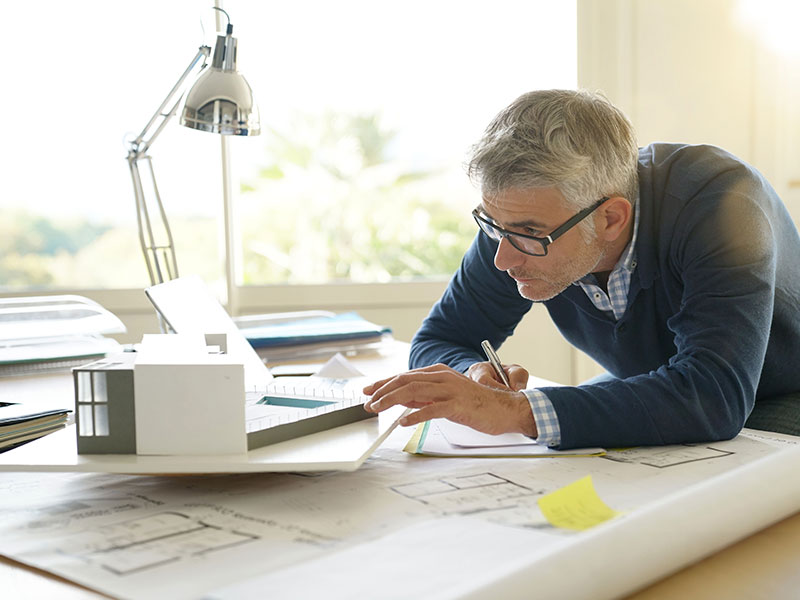Recognizing the Diverse Profession Paths Available for Aspiring Architect
As an ambitious Architect, you have a world of profession courses awaiting you. Each path offers one-of-a-kind challenges and chances to apply your creative thinking and technical knowledge. Whether you're attracted to traditional architecture or the subtleties of lasting style, there's a niche that lines up with your interests. Recognizing these diverse alternatives can shape your professional trip, however which direction will you choose to discover initially?
Traditional Architecture: Designing Frameworks and buildings
Conventional style concentrates on making buildings and frameworks that blend functionality with aesthetic charm. As you discover this field, you'll appreciate the detailed balance in between kind and objective. You'll discover to attract inspiration from historical styles, including elements like symmetry, products, and workmanship. Your layouts can mirror social heritage, showcasing neighborhood traditions while fulfilling modern-day requirements.
You'll develop abilities in drafting, model-making, and site analysis, allowing you to visualize and communicate your concepts effectively. Involving with customers, you'll require to recognize their vision and convert it into practical styles.
Furthermore, constructing codes and sustainability practices are crucial in your work, ensuring your structures are ecologically pleasant and safe. As you expand in your occupation, you'll discover possibilities in domestic, commercial, or perhaps restoration projects, each offering one-of-a-kind obstacles. Embracing conventional architecture leads the way for a fulfilling career that admires the past while forming the future.
Urban Planning: Forming Neighborhoods and Public Spaces
As an aspiring Architect, you can play a crucial role as a city coordinator, changing exactly how neighborhoods engage and function. By employing area engagement methods, you'll assure that citizens have a voice fit their setting. And also, incorporating sustainable style principles will help develop areas that not just satisfy today's demands but also secure the future.
Role of Urban Planners
While numerous could think of engineers as the sole visionaries behind buildings, metropolitan planners play a vital duty in forming the more comprehensive landscape of communities and public rooms. By collaborating with numerous stakeholders, you'll help develop parks, transportation systems, and residential locations that advertise social communication and availability. Your experience in spatial style and neighborhood dynamics permits you to imagine future growth while protecting social heritage.
Area Interaction Techniques
Efficient area involvement techniques are important for urban organizers to guarantee that the voices of homeowners are listened to and valued in the preparation process. To foster meaningful discussion, you should prioritize open forums and workshops where area participants can share their ideas and worries. By actively listening and including feedback, you'll develop spaces that mirror the community's demands, eventually leading to even more successful and lasting metropolitan environments.
Lasting Design Principles
When making city rooms, integrating lasting design principles is crucial for creating atmospheres that prosper both ecologically and socially. Take into consideration incorporating environment-friendly rooms, like yards and parks, to boost biodiversity and boost air top quality.
Designing with water preservation in mind is likewise vital-- think of rainfall yards and permeable surfaces to take care of stormwater. Entailing community participants throughout the preparation procedure warranties that the rooms you develop fulfill their requirements and urge social communication. By embracing these principles, you'll add to dynamic, sustainable metropolitan landscapes that benefit everyone.

Landscape Architecture: Developing Sustainable Outside Atmospheres
As you discover landscape design, you'll discover important style concepts that produce useful and gorgeous outdoor rooms. Lasting methods play an important role in guaranteeing these atmospheres flourish while lessening ecological impact. And also, you'll discover a selection of career chances that permit you to make a real distinction in just how people engage with nature.
Layout Principles in Landscape
Understanding layout principles in landscape style is essential for creating lasting exterior atmospheres that balance with nature. You'll require to consider elements like range, proportion, and equilibrium to ensure your layouts really feel cohesive and welcoming. Including indigenous plants not only enhances biodiversity but also reduces water usage, making your landscape resistant. Think of the flow of space and exactly how people communicate with it; pathways and seating locations ought to invite expedition and relaxation. Additionally, take notice of seasonal changes, making with materials that complement the surroundings year-round (Architect). By focusing on sustainability and visual appeals, you can create exterior spaces that improve the neighborhood and advertise well-being. Embracing these concepts will establish a strong structure for your job in landscape architecture.
Sustainable Practices Summary
Lasting techniques in landscape design not just focus on visual appeals yet additionally prioritize environmental wellness and resource conservation. By integrating indigenous plants, you improve biodiversity and reduce the requirement for chemical fertilizers and pesticides. Carrying out efficient watering systems assists conserve water and lessens runoff, safeguarding neighboring ecosystems. You can design areas that advertise dirt health and wellness, such as exercising and using natural products permaculture concepts. In addition, incorporating environment-friendly facilities, like rain gardens and permeable pavements, help in stormwater management and minimizes metropolitan heat. You contribute to a much healthier earth and provide spaces that foster neighborhood connection when you develop outdoor atmospheres with sustainability in mind. Eventually, these practices assure your styles benefit both people and the atmosphere for many years to find.
Occupation Opportunities Expedition
With a solid foundation in lasting methods, landscape design uses a range of career courses that allow you to make a purposeful influence on the environment. You might function as a landscape developer, developing visually pleasing and useful exterior areas, or concentrate on ecological reconstruction, assisting to restore broken communities. Urban coordinators typically team up with landscape designers to produce green spaces in city settings, improving city livability. If you're enthusiastic concerning education and learning, think about ending up being a landscape style teacher, motivating future generations. Furthermore, you may collaborate with nonprofits focused on environmental sustainability or involve in research study to introduce new practices. Each path not only shapes attractive atmospheres yet also fosters a healthier world for future generations.
Lasting Style: Concentrating on Eco-Friendly Practices
As you explore your profession in architecture, accepting eco-friendly practices can set you apart in a competitive field. Lasting design concentrates on producing buildings that lessen ecological effect while improving occupant health. By including renewable products, energy-efficient systems, and sustainable structure strategies, you'll add to a greener future.
Begin by acquiring expertise of environment-friendly accreditations like LEED or BREEAM, which can reinforce your credentials. Think about how all-natural light, air flow, and thermal effectiveness can enhance layout. Collaborate with engineers and environmental consultants to innovate services that reduce waste and save sources.
Don't forget the importance of neighborhood involvement-- appealing local stakeholders can inspire layouts that balance with the atmosphere. As clients increasingly focus on sustainability, your knowledge in environmentally friendly methods will not only draw in jobs yet likewise meet your enthusiasm for accountable design. Welcome this important facet of Go Here the occupation, and watch your occupation grow.
Historical Preservation: Shielding and Recovering Cultural Heritage
While you begin on your architectural journey, consider the crucial role of historical preservation in maintaining our cultural heritage. This area concentrates on the protection and reconstruction of considerable structures, websites, and structures that inform the stories of our past. By taking part in historical conservation, you'll help safeguard the architectural tradition that shapes community identification.
As a historic conservation Architect, you'll evaluate historical importance and analyze the problem of frameworks. You'll work closely with preservationists and chroniclers to assure authentic repair techniques are employed. This occupation path permits you to mix imagination with research, enabling you to make options that appreciate initial materials and workmanship.
Your work not only contributes to sustainability by recycling existing buildings however additionally fosters a feeling of pride within neighborhoods. Embracing this path will certainly assist you come to be a guardian of background, maintaining the stories and aesthetic appeals that improve our lives.
Interior Architecture: Enhancing Indoor Spaces
Historical preservation and interior architecture both share a dedication to improving the built setting, yet they concentrate on different aspects. While historical preservation stresses keeping a framework's historical and social value, interior style zeroes in on enhancing indoor areas for functionality and aesthetic appeals.
As a hopeful Architect, you'll discover that interior style enables you to blend creativity with technical skills. You'll create areas that not only look excellent yet likewise promote convenience and performance. This area involves understanding exactly how light, color, and materials connect within a space, affecting state of mind and usability.
You'll function on various projects, from household homes to commercial workplaces, making certain that each environment fulfills the needs of its owners. By prioritizing customer experience, you can change insides into functional and motivating spaces, making a considerable effect on exactly how people connect with their environments. Accept the opportunity to enhance interior environments and shape the method people function and live.
Industrial Style: Combining Capability With Looks
Commercial design plays an important duty in developing products that flawlessly blend looks with performance, guaranteeing that what you make use of day-to-day is not just visually appealing but also practical. As an ambitious Architect, you can engage yourself in this field, concentrating on designing everything from furnishings to consumer electronics. Your job includes comprehending user demands, products, and manufacturing procedures, permitting you to develop ingenious services that enhance day-to-day experiences.
In commercial style, you'll usually team up with designers, marketing professionals, and producers, guaranteeing that your styles are not just gorgeous yet likewise feasible. This career course supplies a dynamic environment where creative thinking meets practicality, making it a rewarding choice for engineers interested in forming the products of tomorrow.
Regularly Asked Concerns
What Educational Credentials Do I Need to Come To Be a Designer?
To become an engineer, you'll require a specialist degree in design, commonly a Bachelor's or Master's. Additionally, you'll need to finish an internship and pass the Architect Registration Exam to exercise legitimately.
Exist Qualification Demands for Various Building Job Paths?
Yes, there're qualification try here requirements for numerous building paths. Architect. You'll require to pass examinations, total teaching fellowships, and often pursue specialized training, depending on your chosen focus, like landscape architecture, city style, or historical conservation
What Software Abilities Are Vital for Designers Today?

Exactly How Can I Gain Practical Experience While Examining Architecture?
You can acquire practical experience by interning at architectural firms, participating in layout competitions, volunteering for area tasks, or collaborating with schoolmates on real-world tasks. These possibilities boost your skills and construct valuable connections in the industry.
What Task Opportunities Exist Outdoors Typical Architecture Firms?
You can explore different work chances outside standard architecture companies, like metropolitan preparation, interior decoration, landscape architecture, construction monitoring, real estate development, or also roles in sustainability consulting. Each deals special obstacles and benefits.
Whether you're attracted to typical architecture or the nuances of lasting layout, there's a particular niche that aligns with your passions.When developing urban areas, integrating sustainable design concepts is vital for producing settings that flourish both environmentally and socially.As you explore landscape architecture, you'll uncover crucial design concepts that create practical and stunning outdoor This Site areas.Comprehending design principles in landscape architecture is necessary for creating sustainable outdoor settings that balance with nature.In industrial layout, you'll commonly collaborate with online marketers, suppliers, and designers, making sure that your designs are not just attractive but also viable.